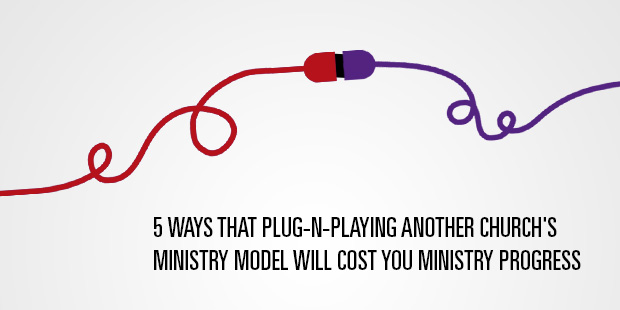
5 Ways That Plug-n-Playing Another Church’s Ministry Model Will Cost You Ministry Progress
At Auxano, we believe that local churches are unmistakably unique and incomparably different. God doesn’t mass-produce His church.
When you try to “plug-n-play” another church’s ministry model, it is going to cost you ministry progress in one or more of these 5 ways:
#1 Secondary Passion Every ministry model was originally designed to bring a deeply desired result or solve an emotionally disconcerting problem. The key dynamic here is the passion at the point of origination that “fuels” the model. If you utilize a model that you don’t develop, the enthusiasm behind it is often less. The passion is derivative and a generation removed from the model itself. Whoever is running Andy Stanley or Mike Breen’s model will not likely embody their passion.
#2 Underutilized Strengths Every ministry model has strengths and limitations. So does your congregation. If you plug-n-play another model you probably won’t optimizing the unique strengths, assets, congregational heritage, leadership learnings and Spirit-led passions of your ministry. For example Andy Stanley’s three-step strategy or Mike Breen’s ideal size for a missional community have certain alignment features with local strengths.
#3 Cultural Disconnect Every ministry model is contextualized for some group of people. Within the model are core assumptions about people, embedded language and values about how to best engage and organize and teach and train and practice the myriad of one-another commands of Scripture. If you cut-n-paste a ministry model you risk a disconnect on all kinds of levels. Some might be big and obvious. Others— and most of them—are small and nuanced. For example, when my friend Vince Antonucci planted a church on the Las Vegas strip, he could not rely on the “attractional pull” of an Andy Stanley’s worship service model or the “extended family” assumptions of Mike Breen’s model. Due to the overt sexuality on the Vegas strip and the skepticism of meeting in people’s homes, the primary environment for Verve Church is gender-based small groups that meet in public “third spaces.”
#4 Less Satisfaction It never ceases to amaze me how much people love designing their own ministry model. (When someone can show them how.) It’s more of a job than a joy when you are running someone else’s playbook. Every time. The bottom line is that photocopying another church’s model of ministry is much less enjoyable and exciting. There is a much deeper sense of “call satisfaction” and freedom to “be who you are” when you design your own. And progress is always an immediate result when you do. You don’t work for Andy Stanley or Mike Breen. You work for the same God that called them and led them to design their own model. God will do the same for you.
#5 Faulty Measurement Every ministry model, when operating well, will have clear input and outputs (means vs. ends). For example, Andy Stanley’s strategy has environment “inputs” and faith catalyst “outputs.” Mike Breen has ministry vehicle “inputs” and life shape “outputs.” Effective discipleship takes place when leaders are focused on the outputs in way that frees them to adjust the inputs. But when you borrow a ministry model, it is much easier to focus only on the inputs. The reason for this is twofold. First, in the desire to get the same attendance results of the ministry being copied, there is more of a preoccupation of “the how.” Second, “the how” or the methodology itself is much more “concrete” and measurable that the output of the methodology. Hence we tend to measure how many people “attend” what we are doing than the results that are coming from the attendance. Model makers are not as inclined to disconnect the means verses the ends of their model. As one famous Christian educator said, “Beware of the ends-means inversion in ministry.”
Read more from Will here.

Tags: Ministry Model, Plug n Play, Vision Frame, Will Mancini












